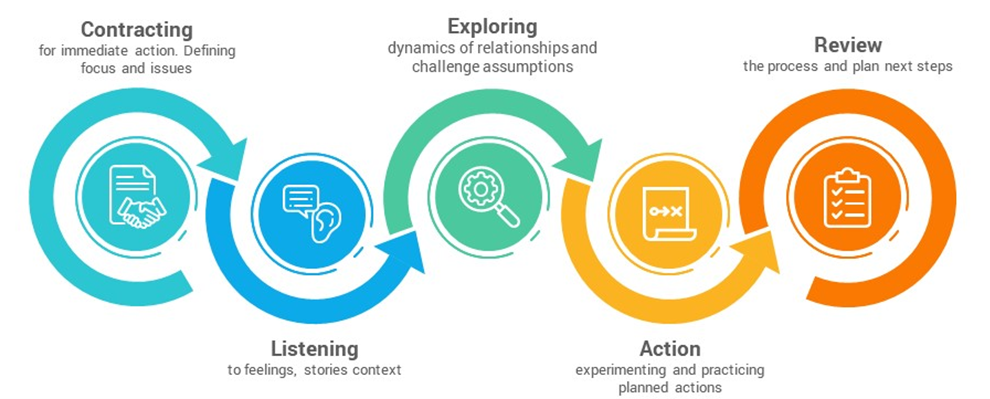People Management: Mastering the Art of Giving and Receiving Performance Feedback
Written by Don Ford on September 6, 2023

Management in a complex, changing world
Performance feedback is a critical component of any successful workplace. It is a tool that helps individuals and teams grow, develop, and achieve their full potential. Managers play a pivotal role in this process, as they are responsible for both giving and receiving feedback. However, providing feedback can be a challenging and delicate task, since we are never certain how feedback will be received. In this blog post, we’ll explore some strategies and best practices for managers on how to give and receive performance feedback effectively.
Performance Feedback Defined:
Performance feedback is information we receive in response to our behavior. It may be reinforcing feedback that tells us our actions were effective and thus we should keep doing them. Or, it may be constructive feedback that tells us our behavior was ineffective but offers insight on how to correct it. Feedback should not be offered with an intent to attack others or hurt their feelings. Negative feedback does more harm than good.
Giving Performance Feedback:
Prepare in Advance: Before deciding to provide feedback, take the time to gather relevant data and observations. This will help ensure that your feedback is specific, accurate, and behaviorally-anchored. Ask employees to reflect upon and self-assess their own performance before offering your viewpoint.
Be Constructive, Not Destructive: Feedback should be aimed at helping employees improve, not tearing them down. Do not focus on personality, but on behavior. Use the “sandwich” approach, where you start with positive feedback, then provide constructive criticism, and finish with more positive reinforcement. For example, you can start by complementing the person for something good they have done, then move on to how they can improve and end with your expression of confidence in their ability to grow.
Be Specific: Vague feedback is not helpful. Be specific about what the employee did well and where they need improvement. Use concrete examples and data to illustrate your points.
Listen Actively: After delivering feedback, allow the employee to respond and ask questions. Listening actively demonstrates that you value their perspective and leads to a deeper performance conversation. Expect initial pushback to constructive feedback and avoid getting emotional. It’s natural to defend oneself when confronted with ineffective behavior. It may take time for employees to digest your advice and act on it.
Set Clear Expectations: Provide clear guidance on what improvements are expected and establish a timeline for follow-up. Ensure the employee understands the path forward and has the resources needed to succeed.
Receiving Performance Feedback:
Welcome Feedback: As a manager, you should be a role model for feedback. Encourage your team to provide feedback on your leadership and management style. Create an open and safe environment where feedback is welcomed and leads to improvement.
Stay Open-Minded: When receiving feedback, put your defensiveness aside. Understand that feedback is a gift and an opportunity for growth. Listen carefully to what is being said, and ask for clarification if needed.
Ask for Specifics: Just as you should provide specific feedback, ask for specific examples when receiving feedback. This can help you better understand the issue and identify areas for improvement.
Reflect and Take Action: After receiving feedback, take some time to reflect on it. Consider its validity and whether it aligns with your goals and values. Then, create an action plan to address the areas where improvement is needed.
Seek Mentorship: Don’t be afraid to seek advice and mentorship from more experienced managers or colleagues. They can provide guidance and support as you work on your own development.
Show Appreciation: When someone takes the time to provide you with feedback, express your gratitude. It shows that you value their input and encourages open communication.
Creating a Feedback Culture:
To foster a culture of continuous improvement, make feedback a regular part of your team’s interactions. Encourage all team members to offer constructive feedback whenever it is helpful. Here are some tips:
Regular Check-Ins: Conduct regular one-on-one meetings with your team members to discuss their performance, career goals, and any concerns they may have.
Peer Feedback: Encourage team members to provide feedback to each other. Peer feedback can offer different perspectives and promote collaboration.
Training and Development: Invest in training and development programs for yourself and your team. This can improve skills and facilitate better feedback exchanges.
Recognition: Acknowledge and reward improvements and achievements resulting from feedback. This reinforces the value of feedback and encourages its ongoing use.
In conclusion, effective performance feedback is a crucial element of successful management. It requires careful preparation, open communication, and a commitment to continuous improvement. By mastering the art of giving and receiving feedback, managers can create a workplace culture that fosters growth, development, and success for all. Remember, feedback is a gift that can lead to remarkable progress when given and received with an open mind.

